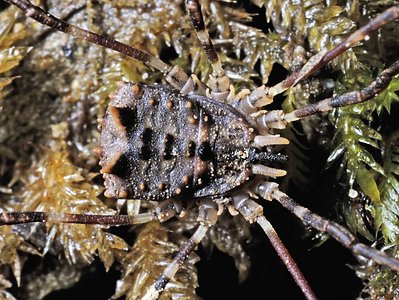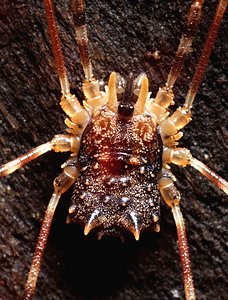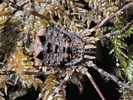Ceratolasma tricantha
Axel SchönhoferIntroduction
Ceratholasma tricantha is the sole member of its genus, distributed along a narrow strip of coastal Redwood forest in northern California and all of Oregon. Characteristics are the three name-giving horn-like processes, two on the front of the prosoma and one on the eye hill, as a unit shielding the chelicerae. These animals are colorful but well camouflaged in their environment. In addition to its unmistakable appearance, the species is unique within harvestmen for having a stridulatory system combining structures on the palps and chelicerae. Genital morphology is rather simple (Gruber 1978).
Taxonomy and Discussion of Phylogenetic Relationships
Closest relatives seem to be Ischyropsalis (Martens 1969, Gruber 1969) and Acuclavella (Shear 1986) based on sternal morphology and other morphological characters. Acuclavella is presumed to be the close sister genus of Ceratolasma. The long terminal process on the eye hill, the form of the cheliceral apophyses in males and the relatively simple and similar penes are shared between both genera and both occur in geographic proximity (Shear 1986). Gruber (1978) re-described Ceratolasma and mentioned some intraspecific morphological variation maybe worth investigating if indicative of cryptic speciation.
Ecology and Life History
Ceratolasma lives in rather humid to moist habitats, often associated with the Redwood forest belt and riverine forest strips within. Animals are most frequently found under logs. A tendency to avoid deep humus and litter and preference of more stable, loamy soils is perceived from personal observation.
References
Goodnight, C. J. and M. L. Goodnight. 1942. New American Phalangida. American Museum Novitates 1164:1-4.
Gruber, J. 1969. Über Stridulationsorgane bei einem Ischyropsalididen: Ceratolasma tricantha Goodnight & Goodnight (Opiliones, Arachnida). Anzeiger der mathematisch-naturwissenschaftlichen Klasse der Österreichischen Akademie der Wissenschaften 105(11):249-255.
Gruber, J. 1978. Redescription of Ceratolasma tricantha Goodnight and Goodnight, with notes on the family Ischyropsalidae (Opiliones, Palpatores). The Journal of Arachnology 6(2):105-124.
Martens, J. 1969. Die Abgrenzung von Biospezies auf biologisch-ethologischer und morphologischer Grundlage am Beispiel der Gattung Ischyropsalis C. L. Koch 1839 (Opiliones, Ischyropsalididae). Zoologische Jahrbücher Systematik 96(2):133-264.
Shear, W.A. 1986. A cladistic analysis of the opilionid superfamily Ischyropsalidoidea, with descriptions of the new family Ceratolasmatidae, the new genus Acuclavella, and four new species. American Museum Novitates 2844:1-29.
Title Illustrations

| Scientific Name | Ceratolasma tricantha |
|---|---|
| Specimen Condition | Live Specimen |
| Identified By | Axel Sch?nhofer |
| Sex | f |
| Life Cycle Stage | adult |
| Copyright |
© 2011 Axel Schönhofer

|
| Scientific Name | Ceratolasma tricantha |
|---|---|
| Specimen Condition | Live Specimen |
| Identified By | Axel Sch?nhofer |
| Sex | m |
| Life Cycle Stage | adult |
| Copyright |
© 2011 Axel Schönhofer

|
About This Page
Many thanks to Angela DiDomenico for the final English check.
Axel Schönhofer

San Diego States University, San Diego, California, USA
Correspondence regarding this page should be directed to Axel Schönhofer at
Axel.Schoenhofer@uni-mainz.de
Page copyright © 2012 Axel Schönhofer
 Page: Tree of Life
Ceratolasma tricantha .
Authored by
Axel Schönhofer .
The TEXT of this page is licensed under the
Creative Commons Attribution-NonCommercial License - Version 3.0. Note that images and other media
featured on this page are each governed by their own license, and they may or may not be available
for reuse. Click on an image or a media link to access the media data window, which provides the
relevant licensing information. For the general terms and conditions of ToL material reuse and
redistribution, please see the Tree of Life Copyright
Policies.
Page: Tree of Life
Ceratolasma tricantha .
Authored by
Axel Schönhofer .
The TEXT of this page is licensed under the
Creative Commons Attribution-NonCommercial License - Version 3.0. Note that images and other media
featured on this page are each governed by their own license, and they may or may not be available
for reuse. Click on an image or a media link to access the media data window, which provides the
relevant licensing information. For the general terms and conditions of ToL material reuse and
redistribution, please see the Tree of Life Copyright
Policies.
- First online 08 July 2012
- Content changed 08 July 2012
Citing this page:
Schönhofer , Axel. 2012. Ceratolasma tricantha . Version 08 July 2012 (under construction). http://tolweb.org/Ceratolasma_tricantha/60684/2012.07.08 in The Tree of Life Web Project, http://tolweb.org/










 Go to quick links
Go to quick search
Go to navigation for this section of the ToL site
Go to detailed links for the ToL site
Go to quick links
Go to quick search
Go to navigation for this section of the ToL site
Go to detailed links for the ToL site